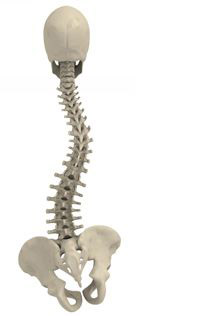
Scoliosis is a curvature and twisting of the spine. Scoliosis most frequently occurs in children and teenagers. However, adults may also be diagnosed with scoliosis.
How does this happen?
Adult scoliosis is separated into 2 common categories:
- Adult Idiopathic Scoliosis patients have had scoliosis since childhood or as a teenager and have grown into adulthood. We do not yet know the cause of idiopathic scoliosis, but there is a lot of genetic work going on in an attempt to answer this question.
- Adult "De Novo" or Degenerative Scoliosis develops in adulthood. Degenerative scoliosis develops as a result of disc degeneration. As the disc degenerates, it loses height. If one side of the disc degenerates more rapidly than the other, the disc begins to tilt. As it tilts, more pressure is placed on one side of your spine and gravity tends to cause the spine to bend and curve. The more discs that degenerate, the more the spine begins to curve.
How is it found?
Both types of adult scoliosis can progress over time. Adults with scoliosis often experience pain, which leads them to seek medical care. Back pain occurs for many reasons including arthritis, inability to stand upright, and/or due to weakness of the core musculature and loss of conditioning. Leg pain/numbness/weakness may develop if there is pressure on the nerves in the lumbar spine. In some cases, changes in the body may include height loss or uneven alignment of the pelvis and hips.
How can this be treated?
The medical evaluation for scoliosis includes a physical exam and X-Rays. Whenever possible, scoliosis in adults is treated non-operatively through physical therapy, medications and other methods. Steroid injections may also help some patients. Surgery may be warranted in patients who have curves that exceed 50 degrees, are not responding to nonsurgical methods or experience other complications.
The most common spinal surgery used to treat scoliosis is spinal fusion. During this procedure, the spine is fused to bone grafts or substitutes to hold the spine in a straighter position. Fusion is often incorporated into other surgical procedures, including, but not limited to:
- Decompression fusion: Pressure is relieved by removing nerves or tissue pressing on the spine, followed by fusion. This procedure is typically performed when the deformity is not severe, and the priority is to relieve symptoms from spinal stenosis (leg pain).
- Surgical stabilization: If scoliosis becomes more severe, screws and rods can be attached to the spine, which are then linked together by metal rods, followed by fusion.
This is the doctor you want!
Dr. Mathew Cyriac
